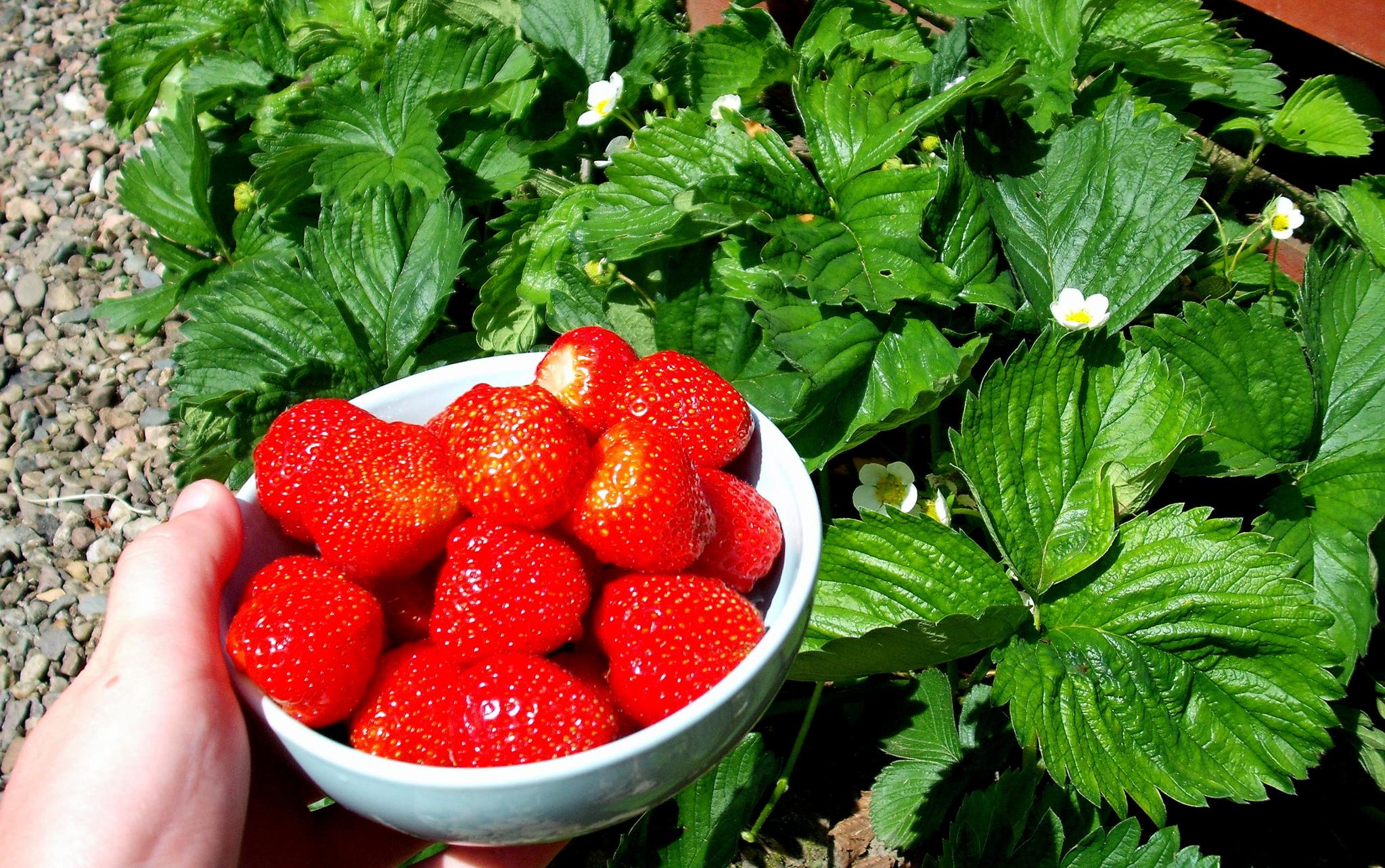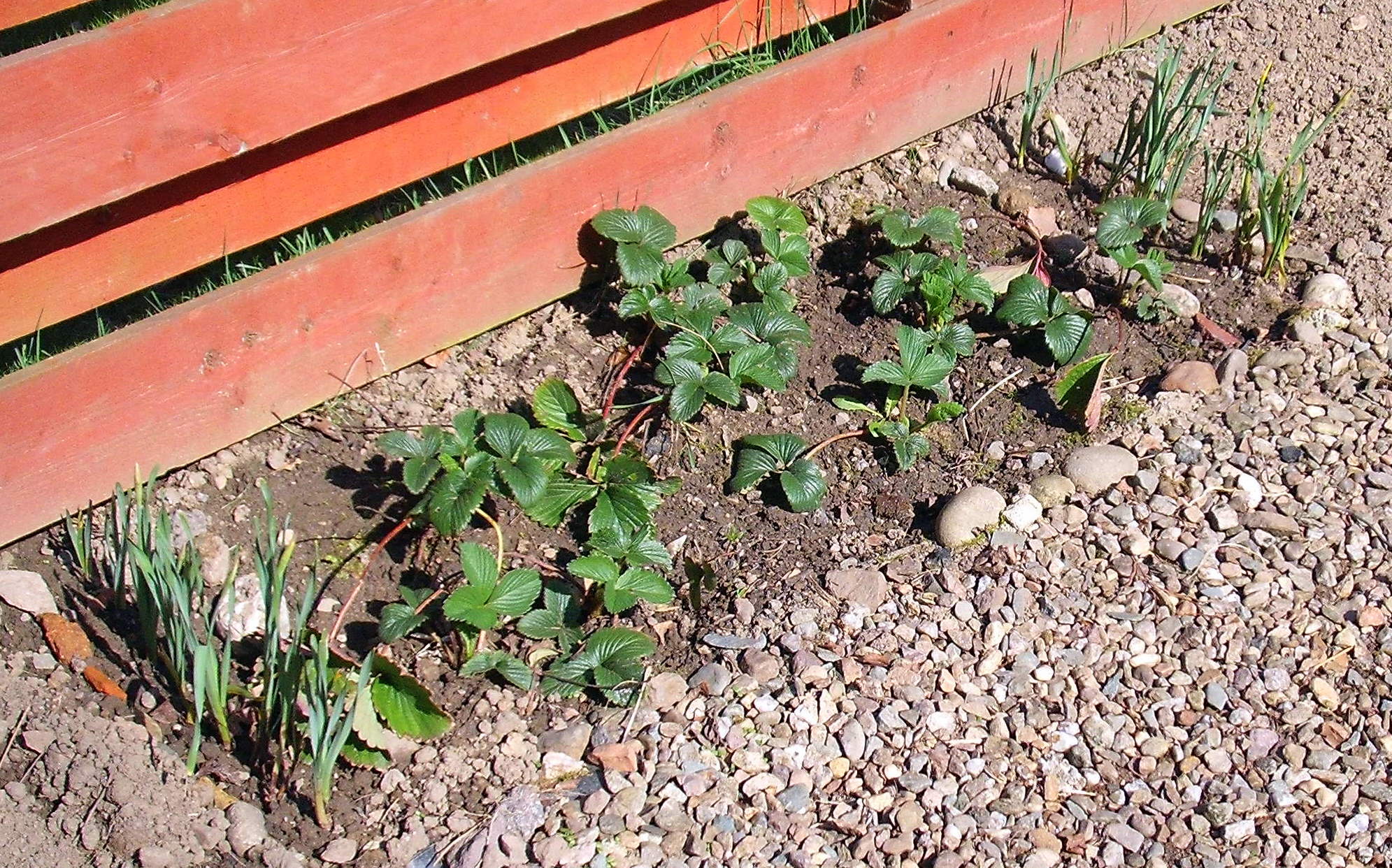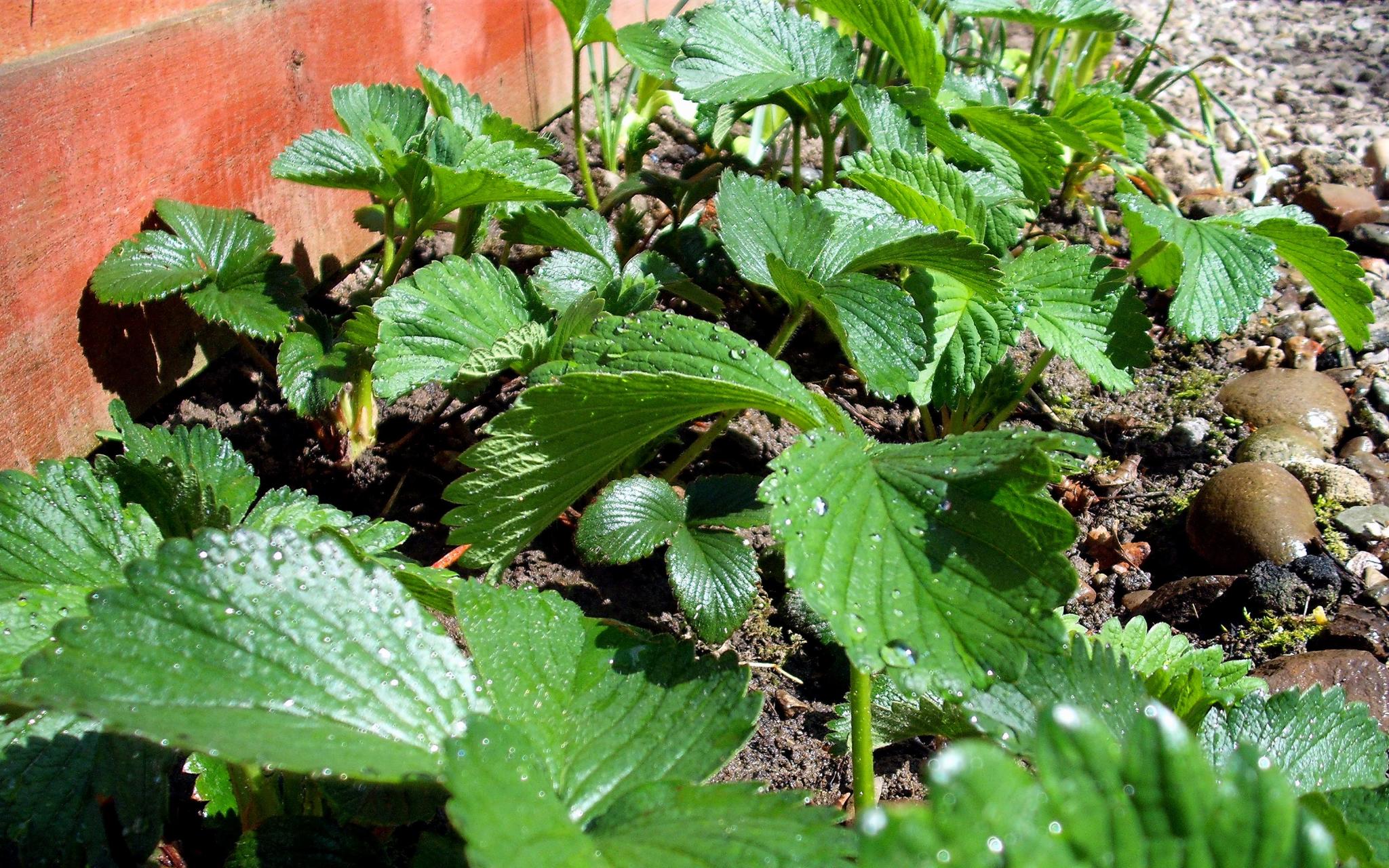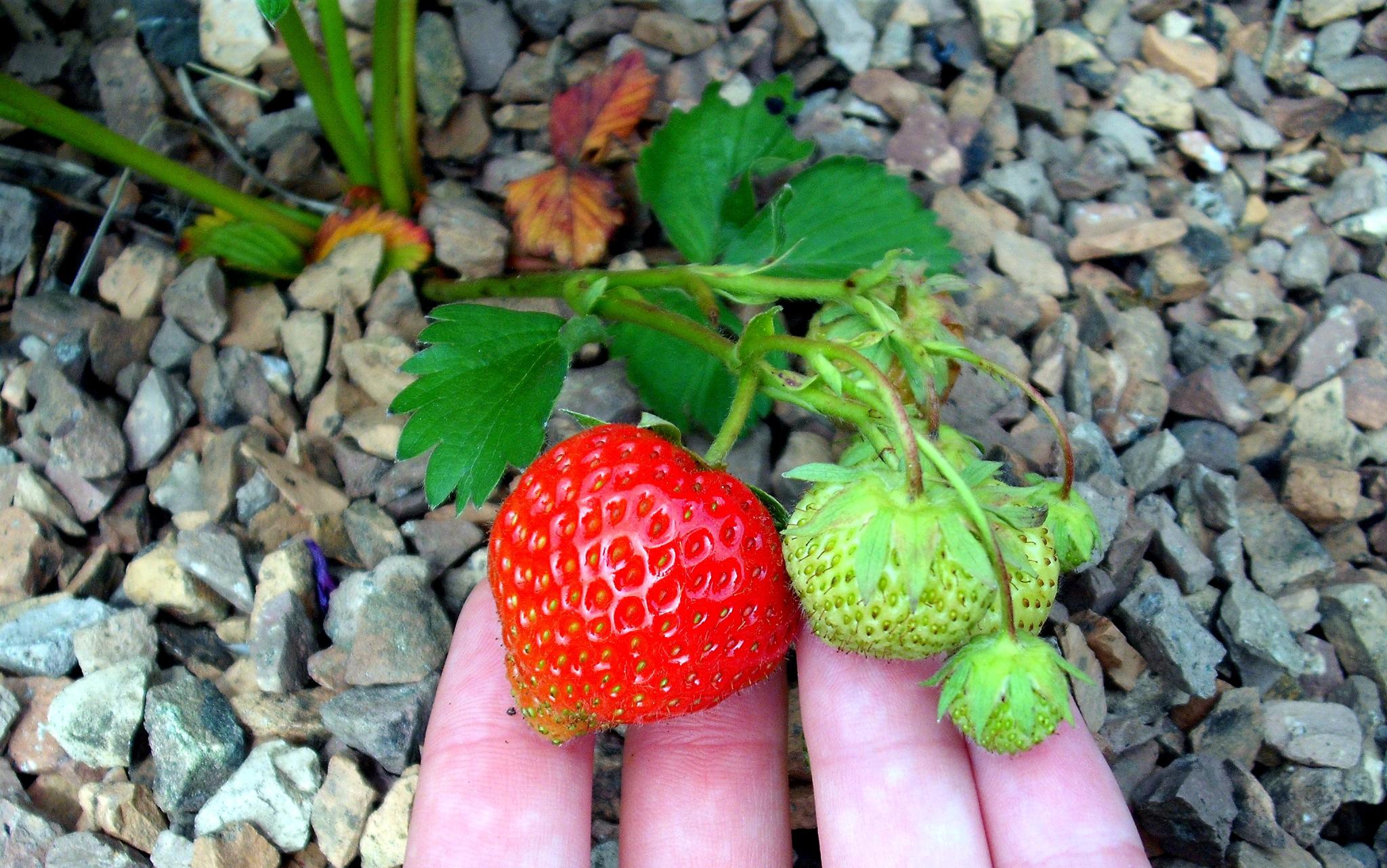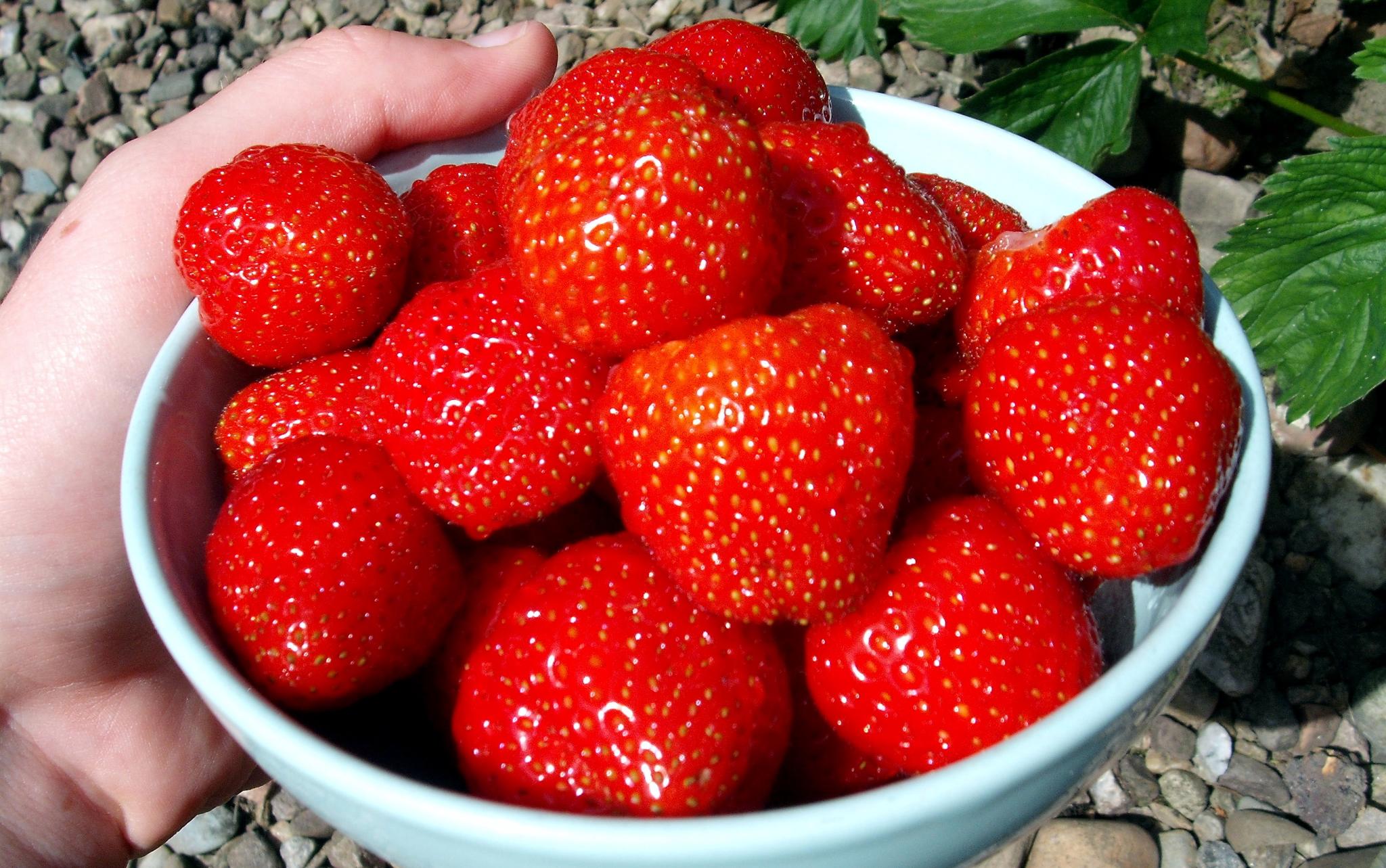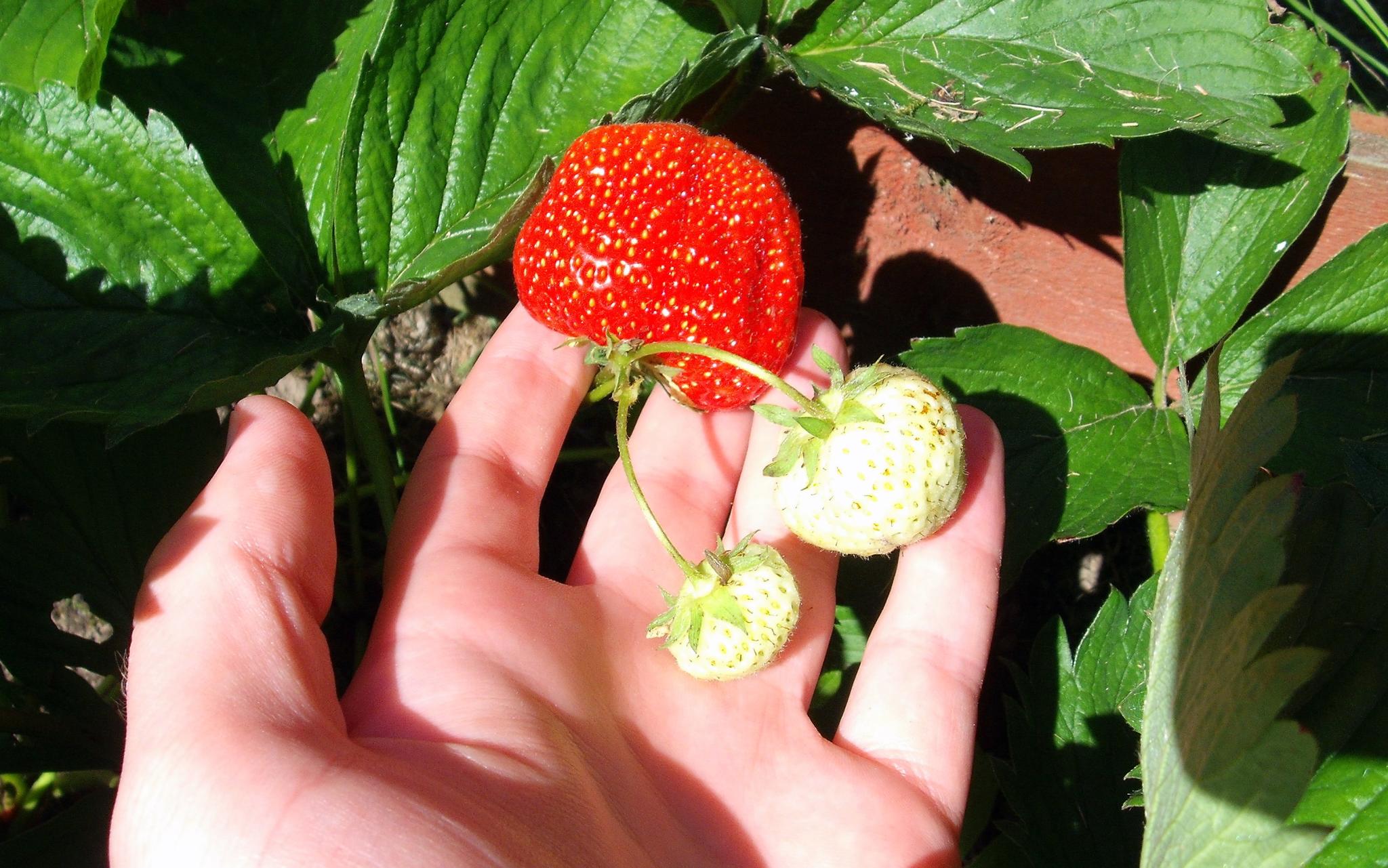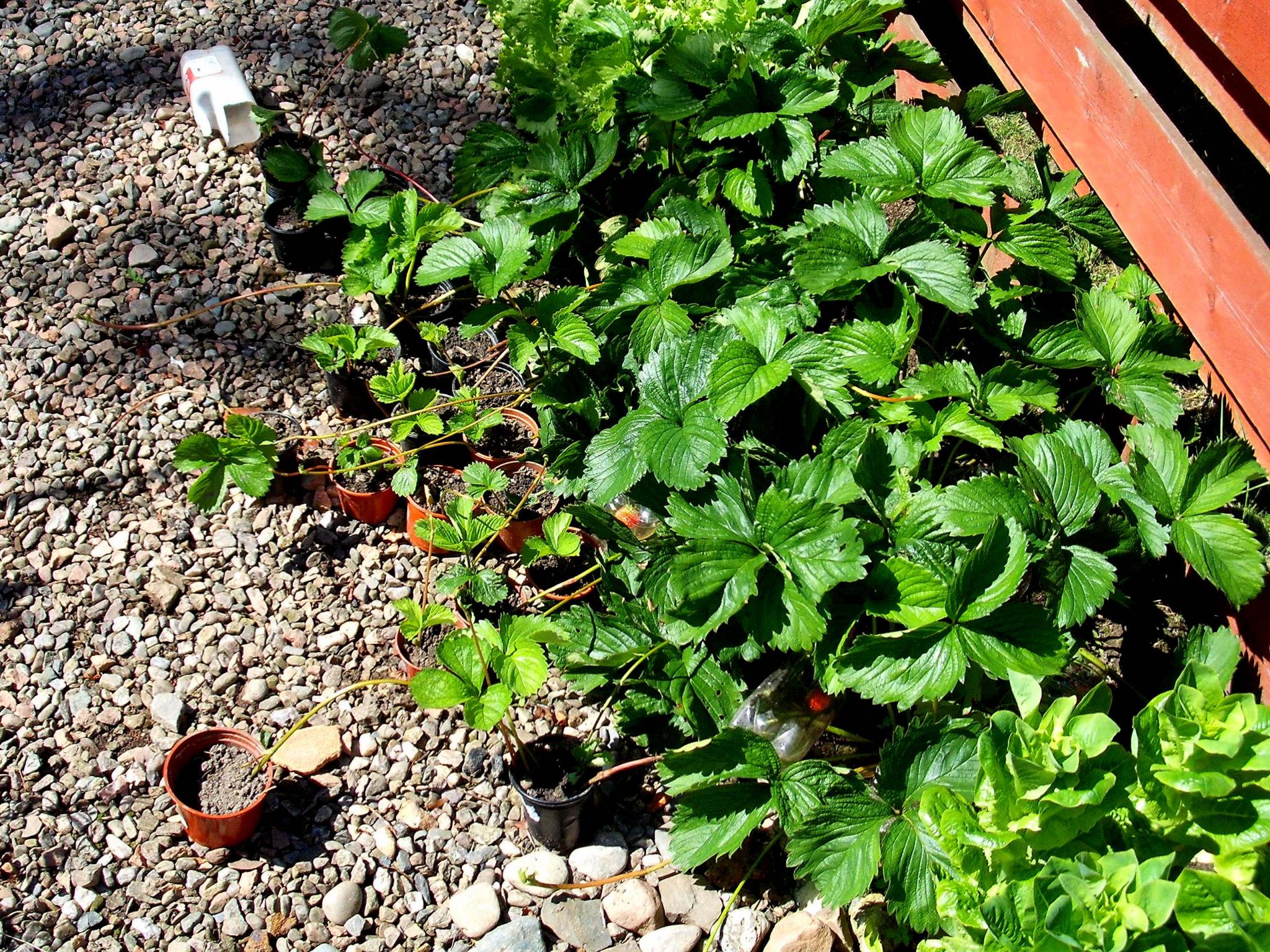What did I do in my gap year? In my gap year, I grew some strawberries.
I grew some last year too. Late last spring, Ruairidh’s Mum gave us some of her excess runners so that we could grow our own plants. I put them in a small border in my back garden, watered them and then let them grow. Come summer, naturally the plants were new and still establishing themselves. Unfortunately, I wasn’t around when what little fruit had grown actually ripened. I try not to think about that cruel summer of ’09. The wound is still too raw.
After the fruit was gone and I was back home the plants did well. We didn’t have a particularly nice summer last year, but it wasn’t awful and the weather was warm right through until the end of October. That was great for my strawberry plants; although they were too young to have produced much fruit, by autumn they had grown sufficiently that they produced a large number of runners to end the season.
What do you do with runners? They’re the shoots that the strawberry plants send out as a way of asexually reproducing. A cloned plant grows on the end of the runner and tries to find soil in order to establish a new, independent plant. This is great if you want more plants, but if the runners are growing before the fruit is finished, resources are being diverted away from making your sweet, sweet strawberries even bigger, juicier and more delicious. That’s bad, so you cut off any runners that form.
However, the majority of my runners were growing harmless after the fruit was gone, so I let them be. And they grew well – the original 5 or 6 plants made so many runners that I didn’t know what to do with them all, as there was hardly any growing space in the back garden available to grow more plants. To begin with I was resigned to chopping the rest off and throwing them away until I realised that I might be able to make some space in the front garden. My front garden is completely gravelled, but I thought I might be able make holes in the ground sheet and let the plants grow through the gravel. If there’s a choice between having lots of strawberries to eat and not having lots of strawberries to eat, I’ll do whatever it takes to make sure I have some. After all, strawberries are delicious.
I decided that I had nothing to lose – even if these plants would never go on to produce a single strawberry, I would be exercising, enjoying the fresh air, having fun listening to podcasts and audiobooks, and learning something too. So in late December, with the runners begging to find soil and take root, I cut them from their parent plants and moved them to the front garden. I felt like a plant surgeon.
I was right, it was fun.  Yes, the gravel was a little frustrating – digging into it is much like digging into sand: the harder you try to dig a hole, the more the sides fall down to fill it back up again. And when I was finally able to reach the ground sheet, the soil beneath didn’t look too promising – it was a solid mass, it looked completely inorganic, and in places it was so far down that a plant would have drowned in the gravel above and around it. Still, most of the 30 or so plants were just about touching the soil. If the Sun kept shining and the plants had the gumption to send out roots to find the soil – and then be able to make use of it once they found it – I thought they might have a chance of surviving.
Yes, the gravel was a little frustrating – digging into it is much like digging into sand: the harder you try to dig a hole, the more the sides fall down to fill it back up again. And when I was finally able to reach the ground sheet, the soil beneath didn’t look too promising – it was a solid mass, it looked completely inorganic, and in places it was so far down that a plant would have drowned in the gravel above and around it. Still, most of the 30 or so plants were just about touching the soil. If the Sun kept shining and the plants had the gumption to send out roots to find the soil – and then be able to make use of it once they found it – I thought they might have a chance of surviving.
As you can see from the photo above, the leaves quickly started turning yellow. Were they not getting enough light? Was I not watering them enough? Were they dying? I had no idea and I still don’t know, but I have a theory: initially, cut off from their host plants, they were unable to maintain the level of health that they had when resources were plentiful. So until their roots embedded in the soil (fueled either by photosynthesis or stored energy) and started absorbing water and nutrients, the leaves yellowed and died. Though I’ve also learned that that’s just what happens with strawberries: most of their leaves die when winter comes. I just hoped that they’d take root before winter really set in.
Was 3 weeks long enough? The plants ran the length of this side of the wall above. It had been frosty for a while and towards the end of December it snowed, completely covering my plants. They wouldn’t see the Sun again until February. There was nothing I could do but wait and enjoy the snow and -12°C temperatures.
When the snow melted, I couldn’t even tell if they’d survived. There was still something left – some dead brown leaves, some larger yellow ones falling off the plants, and some small dark green ones that must have just started growing just before I moved them to the front garden. As spring drew nearer, it was clear that some of the plants were indeed dead, particularly those in deeper gravel that must not have been able to both reach soil and stay in the Sun. They wasted away to almost nothing. But most of the other plants looked alright. They were still tiny – I got rid of any brown or yellow leaves, leaving just those small green ones ((Which is partially what makes me think that all but a few small new leaves will naturally die off every year anyway.)) – but they were not rotting. They must have taken root in December. I kept them watered, and in April they started to get bigger.
The photo above is of my strawberry plants in the back garden that were now a year old. The last frost had passed and the warmth of the Sun was increasing. Although over the winter they had been reduced to stumps with a few small leaves, a fraction of their autumnal size, they were growing again. As in the front garden, I removed the dead leaves and kept them watered. They had survived the harshest winter that I’ve ever experienced.
Being already a year old and well established, the plants in the back garden looked healthier than those in the front, with larger and more plentiful leaves. Here’s a photo of the ones in the back just after being watered at the end of April. And then, like with much of gardening, all I had to do was water the plants every day, and wait ((Surprisingly, slugs did not seem to attack my plants, so unlike pretty much everything in my garden, I didn’t have to defend my strawberries from pests.)).
Waiting was easy; I was in France having a great time. When I returned home at the beginning of June, my plants were in flower:
The flowers are small and white; there are two good – though overexposed ((Probably a fingerprint on the lens.)) – examples here. Once the flower is pollinated ((Thank you bees!)) and finished doing its business, the white petals fall away leaving a little yellow lump on the end of a stalk – you can see a couple at the top of the photo. This is what becomes the strawberry fruit. Over the course of several weeks, it grows larger and heavier, and then suddenly, in a few days it, it ripens from a pale green colour to become a classic red strawberry.
I found my first strawberry on 15th June:
The plants in the front garden, although smaller and newer, were more advanced than those older ones in the back. I think this is because the front garden receives more sunlight in the morning towards midday. The red strawberry here would have been as green as the other strawberries on the bunch just a day or two before. I decided I would leave it one more day to ripen before I sampled the first fruit of my labours.
I never got to eat that strawberry. As it turns out, I’m an idiot and blackbirds are bastards. The next day, the berry was almost all gone and had been rendered inedible. I was furious. This was war. After putting in all those hours planting and then caring for my plants, there was no way I was letting a fucking bird steal my reward. But the birds were fucking with me. The next day, I woke up late and opened my curtains. That second, a blackbird flew to my plants and started tugging at a strawberry. The cheek! I banged the window and it fucked off, but it was too late. When I came to inspect the damage, I found a half eaten strawberry. It wasn’t even nearly ripe. Fuckers.
The common way to protect strawberries, I found out, was with a large net covering the entire plant. But I didn’t have any netting, and my strawberries are positioned in such a shape and location that erecting a net would have been awkward. I had a better idea – I would cover my bunches of strawberries with bottles. 2-litre bottles (those that Pepsi and Coke come in) were the best, I found, and as there was a bit of a family gathering going on and the recycling bin hadn’t been taken away for a little while, there were a load of bottles at my disposal. I wanted clear bottles; I chopped them in half with scissors, and covered the bunches of strawberries with one half. The sunlight would still get through the clear plastic and air would still be able to circulate around the berries, but the birds would no longer be able to reach my fruit. The gravel actually made this easier – I could resculpt it with my hand in order to support the bottles so that they wouldn’t topple.
This solution worked perfectly, and once I had collected enough bottles to cover my needs, I lost no more berries to the birds.
And so, on 18th June 2010, around midday, I ventured into the front garden under the blazing mid-summer Sun to see how my strawberries were doing. Bingo. Red, red, red. Perfectly ripe. They hadn’t grown as large as I had hoped they might – they were first-year plants, after all – but it’s not the size that matters. It’s the taste. I picked all of the ones that I thought were ready to eat, washed them, removed the stalks, and then took this picture:
That’s right. A whole fucking bowl. I weighed them – four hundred fucking grams. That’s how much you get in a supermarket punnet, and it cost me nothing! Then I tasted one. Oh my God, any doubts that I had wasted all my time watering and planting and maintaining vanished instantly. As happens every summer, I remembered just how much I loved strawberries, especially ones straight from the plant. But one is all I ate. Something I’ve learned about strawberries is that although they’re great freshly picked, I like them even more when they’re chilled.
I put them in the fridge and waited for the evening. What a treat.
This continued for a week. My yield from the front garden was steady at about 100 grams per day, and for that I was grateful. They were delicious. Although the berries in the back garden were already much larger than those from the front had been, they were still a week or so from ripening.
But on 25th June, I was going away for 4 weeks.
I returned on 21st July. In the time that I had been gone, the strawberries in the front garden were finished, and there were only a few left in the back. There was one huge ripe one that I ate immediately. It was the best one I’d had all year, but I couldn’t help feeling slightly disappointed at how many I had missed. I would ultimately eat only a third of the strawberries that I grew; my mother and brother picked and ate most of the rest ((With my permission, of course.)).
A few days ago I took a picture of my last large strawberry:
Although there are still a few small berries to ripen over the next few days, strawberry season is practically finished. Of course, that’s not the end of the story.
‘What about some numbers, Wilf?’ Thanks for asking; it just happens that I have some numbers for you. Every time I picked strawberries, I recorded how much my harvest weighed. I measured in grams, using a scale accurate to 20 grams, and when I was away, my Mum measured in ounces, using a scale accurate to the ounce. I converted hers into grams, and made a graph. Let’s have a look at the data:
What can we see?
- The first measurement was my 400 gram haul on 18th June. That’s clearly an anomaly and it’s easy to explain: I had not been picking strawberries up to that date, so there would have been a backlog of ripe strawberries stretching back a few days. The weather was also very good and might have been great for ripening.
- After that day, and through the rest of June, I picked a steady 100 grams every day; this was the front garden in maximum production mode. Next year I would expect this portion of the graph to be level at at least 200 grams, as the plants will be much better established.
- At the beginning of July, the line rises. This is because the strawberries in the back garden began to ripen.
- Around the 4th July, there is a peak when the plants in the back garden produce their maximum load. The weather was all particularly good in the preceding days, resulting in more of the fruit ripening at once.
- Combined with the end of the front garden’s production and a fall after this exceptional maximum, the line then decreases quite sharply until the back garden alone is producing about 50 grams a day for the rest of the month.
- The final peak is unexplained.
The total yield was approximately 4.5 kilograms, equivalent to 10 supermarket punnets – about £20 worth!
Fascinating. And delicious.
Overall, I’m extremely pleased with my plants, and I don’t feel that I’ve wasted a minute on them. I hope next year I’ll be home for more of the season – what with my more mature plants, as well as the new ones I’ll plant, I predict I’ll grow at least 10 kilograms.
My final problem, now that the berries are gone, is that the new runners are growing insanely quickly. This year I’m letting them root into pots filled with soil so that they can establish as independent plants before I relocate them. I’ve already used 100 pots, and there are still more shoots growing:
This afternoon, about a week after potting most of the runners, I removed a few from their pots to see how they were progressing. They’re doing great, sending out plenty of roots and starting to grow independently of their hosts.
Finally, what will I do with these 100+ strawberry plants? I’ve not decided. I think I may be able to find room for another 20 in the front garden, but the rest will need to be planted elsewhere. Yet I can’t bring myself to throw them away – as I’ve said, I’d much rather have strawberries than no strawberries, and I’m happy to do the work to make that so. Perhaps neighbours might want them; perhaps I’ll plant some in my Grandma’s garden (she lives nearby); or perhaps I’ll find a spot somewhere out in the wild so that the whole world can enjoy them.
I’ll let you know what happens.
If you want to know more about strawberries, read Wikipedia’s article on garden strawberries. I haven’t read it, but I bet it’ll be good and much more informative than this post. You know the Wikipedians write good stuff.

